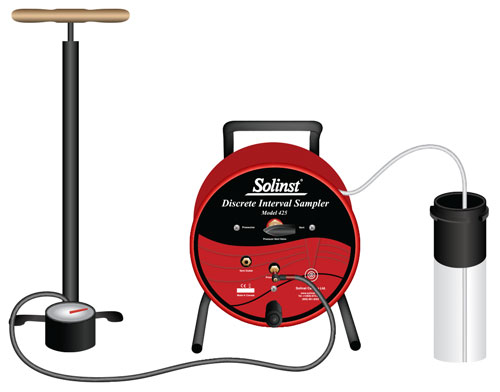Discrete Interval Sampler - Operating Principles
Operating Steps

High Pressure Hand Pump Tubing Reel with Pressure/Vent Valve

1. Using the hand pump, pressurize the Discrete Interval Sampler (DIS) to the required pressure (Pressure/Vent Valve is switched to Pressurize on the reel). The actual pressure needed is calculated based on sampling depth below grade minus static level below grade in feet (meters), multiplied by 0.43 (9.8), with 10 psi (70 kPa) added (e.g. 100 ft (30 m) sampling depth - 30 ft (9 m) to static x 0.43 (9.8) + 10 psi (70 kPa) = 40 psi (275 kPa) needed).
- A: Pressure forces the bottom check valve closed to prevent water from entering the pump while it is being lowered.
2. Disconnect the hand pump from the reel, then lower the DIS into the well to the desired sampling depth. A cable connector is included at the top of the DIS for easy connection to a suspension cable or Model 103 Tag Line.
Note:
For sampling at depths more than 60 m (200 ft) below water level, pressurize the DIS to 100 psi, then lower the sampler to 50 m (160 ft) below water. Increase the pressure to the maximum required, then lower the sampler to the appropriate level. Do the same when retrieving the DIS. Warning: DIS is not designed for use at depths greater than 90 m (300 ft) below static water.
3. At the sampling depth, turn the Pressure/Vent Valve to Vent. Allow 1-3 minutes for the DIS to fill.
- B: The bottom check valve opens, allowing hydrostatic pressure to fill the DIS.
- C: The sample water forces the top check valve closed, which prevents the sample water from entering the tubing.
4. Reconnect the hand pump, switch the Pressure/Vent Valve back to Pressurize, repressurize the DIS as in Step 1.
- D: The bottom check valve closes with the pressure to prevent the sample water from exiting the DIS, ensuring the sample chemistry remains intact as the sample is retrieved.
5. At the surface, turn the Pressurize/Vent Valve to Vent. Use the Sample Release Device to unseat the bottom check ball and collect the sample.



